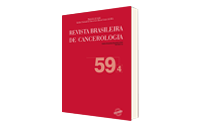The Inflammatory Mosaic in the Histological Subtypes of Basal Cell Carcinoma
DOI:
https://doi.org/10.32635/2176-9745.RBC.2013v59n4.971Keywords:
Humans, Skin Neoplasms, Carcinoma, Basal Cell-physiopathology, Carcinoma, Basal Cell-pathology, Mast CellsAbstract
Introduction: Basal Cell Carcinoma (BCC) is defined as a slow-growing locally invasive tumor. As it spreads, it elicits a chronic inflammatory process with the recruitment of several cell types. Objective: To characterize the inflammatory infiltrate describing the different subtypes of BCC through the identification and quantification of its cells. Method: This was a retrospective study of 71 paraffin blocks from patients diagnosed with non-recurrent BCC. The immunohistochemical analyses were performed using the Streptavidin-biotin-peroxidase technique (CD3, CD20, CD68, CD8, CD4, and Ki-67 cell MAST), and the toluidine blue technique for mast cells. Results: The most frequent subtypes found were infiltrating (26%) and superficial (23%) BCC. Regarding the composition of the inflammatory infiltrate, the TCD 4 + lymphocytes corresponded to the largest population (216.2 ± 22.23), followed by mast cells (111.0 ± 7.88), TCD8 + lymphocytes (57.38 ± 5.94), B lymphocytes (55.9±6.83) and macrophages (21.18 ± 2.58). The total cell proliferative activity was generally low (47.61 ± 7.48), except for more aggressive forms of the disease, in which infiltrates rich in mast cells could be found. The adenoid subtype showed a denser infiltrate, while the Cystic subtype presented a scanty infiltrate. There was an inverse relationship between the number of mast cells and the number of T lymphocytes, without correlation with aggressiveness. Conclusion: In the BCC, the peritumoral inflammatory infiltrates suggests an immune response mediated by TCD 4+ and a composition which varies according to the type of tumor. It has been suggested that the characteristics of each tumor type might reveal differences in the tumor tissue microenvironment, which cause alterations in the composition of the infiltrate, thereby favoring or impeding tumor growth.









